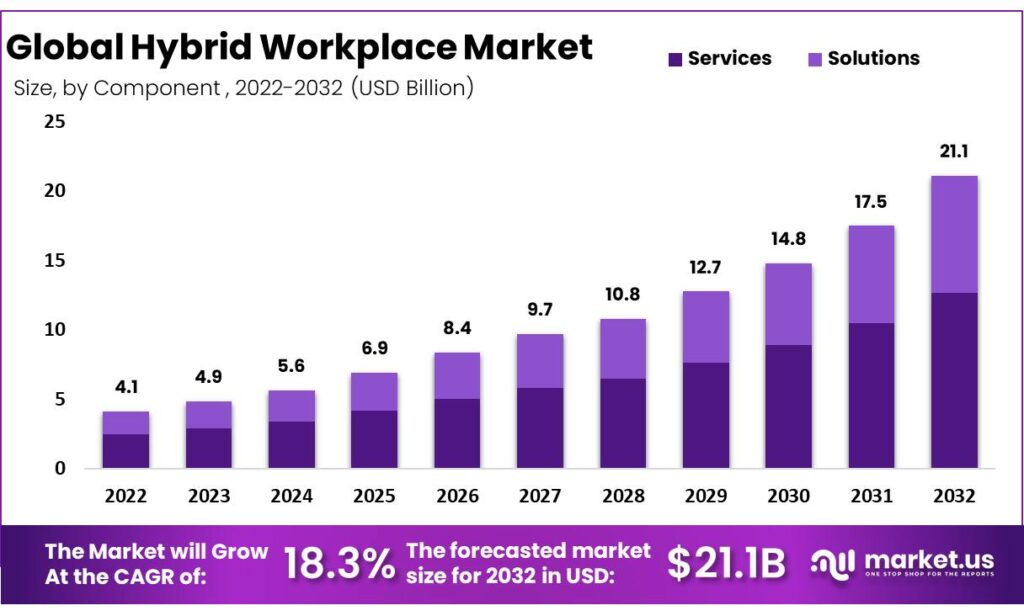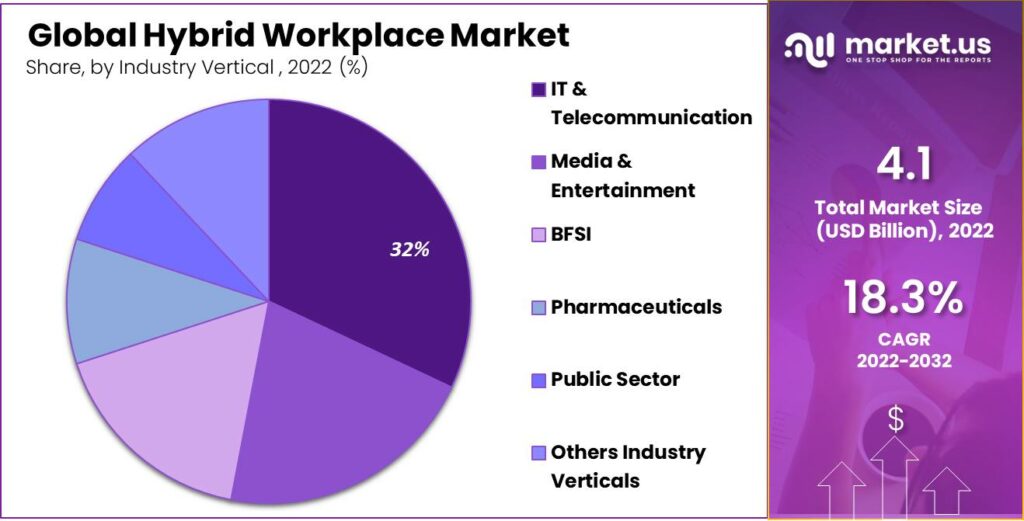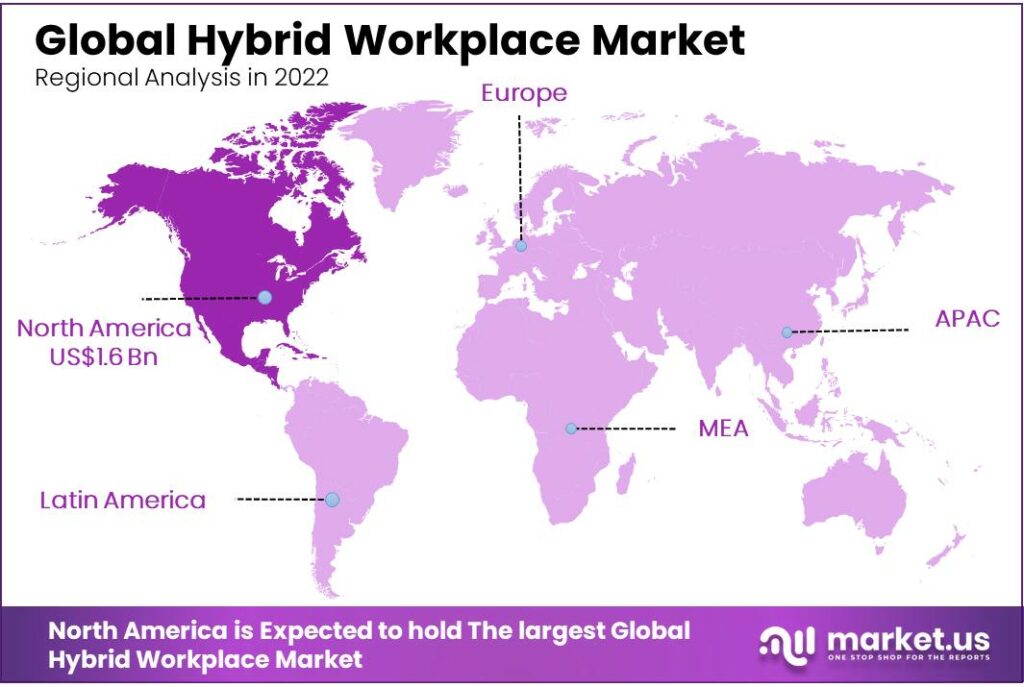New York, Jan. 10, 2024 (GLOBE NEWSWIRE) -- According to Market.us, The Global Hybrid Workplace Market is likely to jump from USD 5.6 Billion in 2024 to USD 21.1 Billion by 2032. This projected expansion is anticipated to result from an average 18.3% CAGR in the demand for the hybrid workplace industry over the upcoming decade.
The concept of the hybrid workplace gained significant attention and adoption due to the COVID-19 pandemic. Many organizations were forced to implement remote work policies to ensure business continuity and employee safety. As a result, companies realized the potential benefits of remote work, such as increased productivity, cost savings, and improved work-life balance.
The hybrid workplace model has the potential to improve employee well-being and engagement by providing greater autonomy and flexibility. Organizations are investing in tools and programs that support employee mental health, promote work-life balance, and foster a sense of connection and belonging among remote and in-person employees.
The report provides a full list of key companies, their strategies, and the latest developments. Download a PDF Sample before buying

("Before you plan to Invest? Explore our comprehensive studies or reports by opting for sample reports. They provide an excellent opportunity to assess the depth and quality of our analyses before making a decision.")
Key Takeaways
- Market Growth: The global hybrid workplace market was valued at USD 4.9 Billion in 2023 and is projected to reach USD 21.1 Billion by 2032, with a remarkable Compound Annual Growth Rate (CAGR) of 18.3% during this period. This substantial growth highlights the increasing adoption of hybrid work models.
- Market Components: The hybrid workplace market encompasses a wide range of solutions and services, including collaboration software, video conferencing tools, project management platforms, cloud-based storage, cybersecurity solutions, and ergonomic home office equipment.
- Market Size by Component: Services dominate the market, accounting for 60% of market revenue. The growing demand for remote and online services such as virtual collaboration tools, IT support, and cybersecurity solutions contributes to this dominance.
- Market Size by Size: Small and Medium-sized Enterprises (SMEs) hold a significant share, representing 72% of the market. However, large enterprises are expected to experience growth due to the increasing adoption of hybrid work models and growing demand for office space.
- Key Industry Vertical: The Information Technology and Telecommunication sector is the most lucrative industry vertical within the hybrid workplace market, holding the largest revenue share of 32%.
- Regional Analysis: North America leads the market, accounting for about 39% of the share, followed by Europe and the Asia-Pacific region. The presence of major IT companies in North America and the adoption of hybrid work models contribute to its dominance.
- Key Market Players: Prominent companies in the hybrid workplace market, including TCS, Target, Salesforce, Nike, and IBM, are adopting strategies like mergers, collaborations, and acquisitions to enhance their market presence and quality.
For details on companies and their offerings "Buy a report"!
Factors influence the growth of Hybrid Workplace Market
- Shifting Workforce Preferences: The hybrid workplace market is witnessing significant growth due to the preferences and expectations of the workforce. Many employees seek flexibility and an improved work-life balance, making the hybrid work model a fitting choice. With a growing number of workers opting for remote or flexible arrangements, the demand for technologies and solutions facilitating seamless collaboration and communication in a hybrid work environment is on the rise.
- Technological Advancements: Technology plays a big role in making the hybrid workplace possible. Good internet, cloud apps, and video tools make remote work easier. The hybrid workplace market grows as technology keeps getting better, improving how we work from different locations.
- COVID-19 Pandemic: Hybrid work models got a big boost from the COVID-19 pandemic. Many companies had to switch to remote work during the pandemic, and they saw that having a mix of remote and in-office work can be successful. Now, these companies are considering keeping this hybrid model for a long time. The pandemic played a key role in speeding up the growth of the hybrid workplace market.
- Cost Efficiency and Business Agility: The hybrid workplace model presents cost-saving opportunities for organizations. By minimizing office space requirements, companies can save on real estate, utilities, and other related expenses. Additionally, this model enables organizations to swiftly adapt to evolving business needs and market conditions. The flexibility to scale the workforce and adjust work arrangements enhances overall business agility.
Gain expert insights and supercharge your growth strategies. Request our market overview sample now: https://market.us/report/hybrid-workplace-market/request-sample/
Report Segmentation
Component Analysis
In 2023, the Services Segment held a dominant market position in the Hybrid Workplace market, capturing more than a 60% share. This segment's robust performance can be primarily attributed to the increasing demand for specialized services that facilitate seamless integration of remote and on-site work environments. Businesses are increasingly investing in services such as consultation, implementation, support, and training to ensure a smooth transition to hybrid models. This trend is further fueled by the growing emphasis on enhancing employee experience, productivity, and collaboration across geographically dispersed teams.
Size Analysis
In 2023, the Small & Medium-sized Enterprises (SMEs) Segment held a dominant market position in the Hybrid Workplace market, capturing more than a 72% share. This significant market share reflects the agility and flexibility of SMEs in adopting new work models. SMEs, known for their dynamic business structures, have rapidly integrated hybrid work systems, which blend remote and in-office work. This shift is primarily driven by the need to maintain competitiveness and adaptability in a rapidly changing business environment. The cost-effectiveness and scalability of hybrid workplace solutions are particularly appealing to SMEs, allowing them to optimize resources while maintaining high productivity levels.
Industry Vertical Analysis
In 2023, the IT & Telecommunication segment held a dominant market position in the Hybrid Workplace market, capturing more than a 32% share. This sector's significant market share can be attributed to its rapid adoption of advanced technologies and the increasing demand for flexible, remote working solutions. The proliferation of cloud-based services and the need for robust cybersecurity measures have further catalyzed this segment's growth.

Scope of the Report
| Report Attributes | Details |
| Market Value (2023) | US$ 4.9 Billion |
| Forecast Revenue 2033 | US$ 21.1 Billion |
| CAGR (2023 to 2032) | 18.3% |
| North America Revenue Share | 39% |
| Base Year | 2023 |
| Historic Period | 2018 to 2022 |
| Forecast Year | 2024 to 2033 |
Want to Access the Statistical Data and Graphs, Request PDF Sample @ https://market.us/report/hybrid-workplace-market/request-sample/
Regional Analysis
In 2023, North America held a dominant market position in the hybrid workplace market, capturing more than a 39% share. This substantial market share can be attributed to the region's advanced technological infrastructure, high adoption rates of digital tools, and a strong presence of leading market players. Furthermore, the widespread acceptance of flexible work arrangements in North American corporate culture has significantly driven the growth of the hybrid workplace model.

Key Market Segmentation
Based on Component
- Solutions
- Services
Based on Size
- Small & Medium-sized Enterprises
- Large Enterprises
Based on Industry Vertical
- Public Sector
- Pharmaceuticals
- Media and Entertainment
- IT and Telecommunication
- BFSI
- Others Industry Verticals
By Geography
- North America
- The US
- Canada
- Europe
- Germany
- France
- The UK
- Spain
- Italy
- Russia
- Netherland
- Rest of Europe
- APAC
- China
- Japan
- South Korea
- India
- Australia
- New Zealand
- Singapore
- Thailand
- Vietnam
- Rest of APAC
- Latin America
- Brazil
- Mexico
- Rest of Latin America
- Middle East & Africa
- South Africa
- Saudi Arabia
- UAE
- Rest of MEA
Competitive Landscape
The competitive landscape of the market has also been examined in this report. Some of the major players include:
- TCS
- Target
- Salesforce
- Nike
- Nationwide
- Klarna
- P. Morgan
- IBM
- General Motors Co.
- Ford Motor Co.
- Flipkart
- Citigroup
- Other Key Players
Explore More Ongoing Coverage in the Information and Communications Technology Market Research Reports
Domain:
- Autonomous Mobile Robots Market was worth USD 4.3 Bn in 2023 and is projected to reach USD 18.2 Bn by 2032 with a CAGR of 18.1%.
- Predictive Analytics Market size to reach USD 9.5 Bn In 2022 and is Projected To Reach a Revised Size Of USD 61.9 Bn By 2032
- Artificial Intelligence (AI) in Agriculture Market is expected to grow at a CAGR of 24.5% over 10 years and will reach USD10.2 Bn in 2032
- Business process outsourcing market is expected to grow by USD 544.8 billion in 2032, registering a CAGR of 8.5%.
- Online dating market size is expected to be worth around USD 23.80 Billion by 2032 growing at a CAGR of 9.20% during forecast period.
- Space tourism market accounted for USD 847.7 million in 2022 and is expected to reach USD 17,742 million by 2032, with a 36.6% CAGR.
- Customer Experience Management Market projected to be valued at USD 57.9 billion in 2033, register a growth rate of 15.1%.
- Web3 Market is likely to attain a valuation of USD 177.58 Billion by 2033, projected to develop at a CAGR of 44.1% from 2024 to 2033.
- Extended Reality Market generated valued at USD 49.6 Bn in 2023 and is estimated to reach USD 519.5 Bn by 2032
- Intelligent Document Processing Market size reached USD 1933.5 Million in 2023 and expects the market to reach USD 17,826.4 Million by 2032.
- Embedded Systems Market is to grow at a CAGR of 6.8% over the next 10 years. It will reach USD 173.4 Bn by 2032, from USD 91.3 Bn in 2022.
- Image Sensors Market is expected to grow at a CAGR of roughly 8.1%. It will reach USD 55.8 Bn in 2032, from USD 28.2 Bn in 2023.
- Blockchain Technology Market size is projected to surpass at USD 12,895 Bn by 2032 and it is growing at a CAGR of 68% from 2022 and 2032.
- Mobility as a Service Market is projected to be worth USD 2,313.2 million by 2033, grow at 13.5% from 2024 to 2033.
- Music Streaming Market is projected to reach USD 125.70 Billion by 2032, with a 15.10% CAGR from 2023 to 2032.
About Us
Market.US (Powered by Prudour Pvt Ltd) specializes in in-depth market research and analysis and has been proving its mettle as a consulting and customized market research company, apart from being a much sought-after syndicated market research report-providing firm. Market.US provides customization to suit any specific or unique requirement and tailor-makes reports as per request. We go beyond boundaries to take analytics, analysis, study, and outlook to newer heights and broader horizons.
Follow Us On LinkedIn Facebook Twitter
Our Blog:
